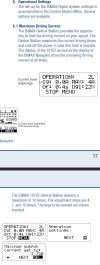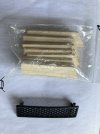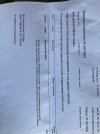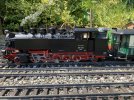I've sent my 21480 2-10-2 to Maerklin in Goppingen for repair under guarantee. The dialogue is interesting, and I'm sure it will help me if some of you will throw in your thoughts on what's going on.
You'll need the background; fiirst the initial problems
* I bought it in April 2022 (new, from Peyker in Austria). At first perfect. Then sometimes a minor irritation: when I placed it on the track, one of the "next station" sounds would go off involuntarily.
* Last season it got worse, sometimes that particular sound would go off while it was running. At the same time, the smoke generator output gradually weakened, so that less and finally nothing came out of the chimney, only around the valve gear. So I thought that since it's under guarantee I'll get them to fix it.
* There is though no Maerklin authorised service centre in CZ. But there is one just across the border in Stollberg, where, by coincidence my niece lives and works. So I took it there in January.
* Communication with that place was a bit difficult but they have a long history so I trusted them, even though when I got it back there was no written indication of what they'd actually done. (My niece's Mum brought it back as she had been up there)
Things then turn worse, the first time I put it on the track.
* Immediately the whistle blows.I can't stop it, and it's loud. But at the same time, the loco doesn't move. I take it off the track. Shut down everything and restart.
* Put it back on track. Same result only now smoke starts billowing but only from the valve gear. Then I smell burning. I whip it off the track and see that the burning is coming from around one contact shoe. I've seen enough, wonder what on earth the service centre is playing at, and get on with trying to contact Maerklin directly.
* everything else on the railway is functioning normally, including the Harz T3 railcar which also has a very sophisticated sound module
Hope it helps if I break this up into two posts, part 2 is what Maerklin are now saying...
You'll need the background; fiirst the initial problems
* I bought it in April 2022 (new, from Peyker in Austria). At first perfect. Then sometimes a minor irritation: when I placed it on the track, one of the "next station" sounds would go off involuntarily.
* Last season it got worse, sometimes that particular sound would go off while it was running. At the same time, the smoke generator output gradually weakened, so that less and finally nothing came out of the chimney, only around the valve gear. So I thought that since it's under guarantee I'll get them to fix it.
* There is though no Maerklin authorised service centre in CZ. But there is one just across the border in Stollberg, where, by coincidence my niece lives and works. So I took it there in January.
* Communication with that place was a bit difficult but they have a long history so I trusted them, even though when I got it back there was no written indication of what they'd actually done. (My niece's Mum brought it back as she had been up there)
Things then turn worse, the first time I put it on the track.
* Immediately the whistle blows.I can't stop it, and it's loud. But at the same time, the loco doesn't move. I take it off the track. Shut down everything and restart.
* Put it back on track. Same result only now smoke starts billowing but only from the valve gear. Then I smell burning. I whip it off the track and see that the burning is coming from around one contact shoe. I've seen enough, wonder what on earth the service centre is playing at, and get on with trying to contact Maerklin directly.
* everything else on the railway is functioning normally, including the Harz T3 railcar which also has a very sophisticated sound module
Hope it helps if I break this up into two posts, part 2 is what Maerklin are now saying...




